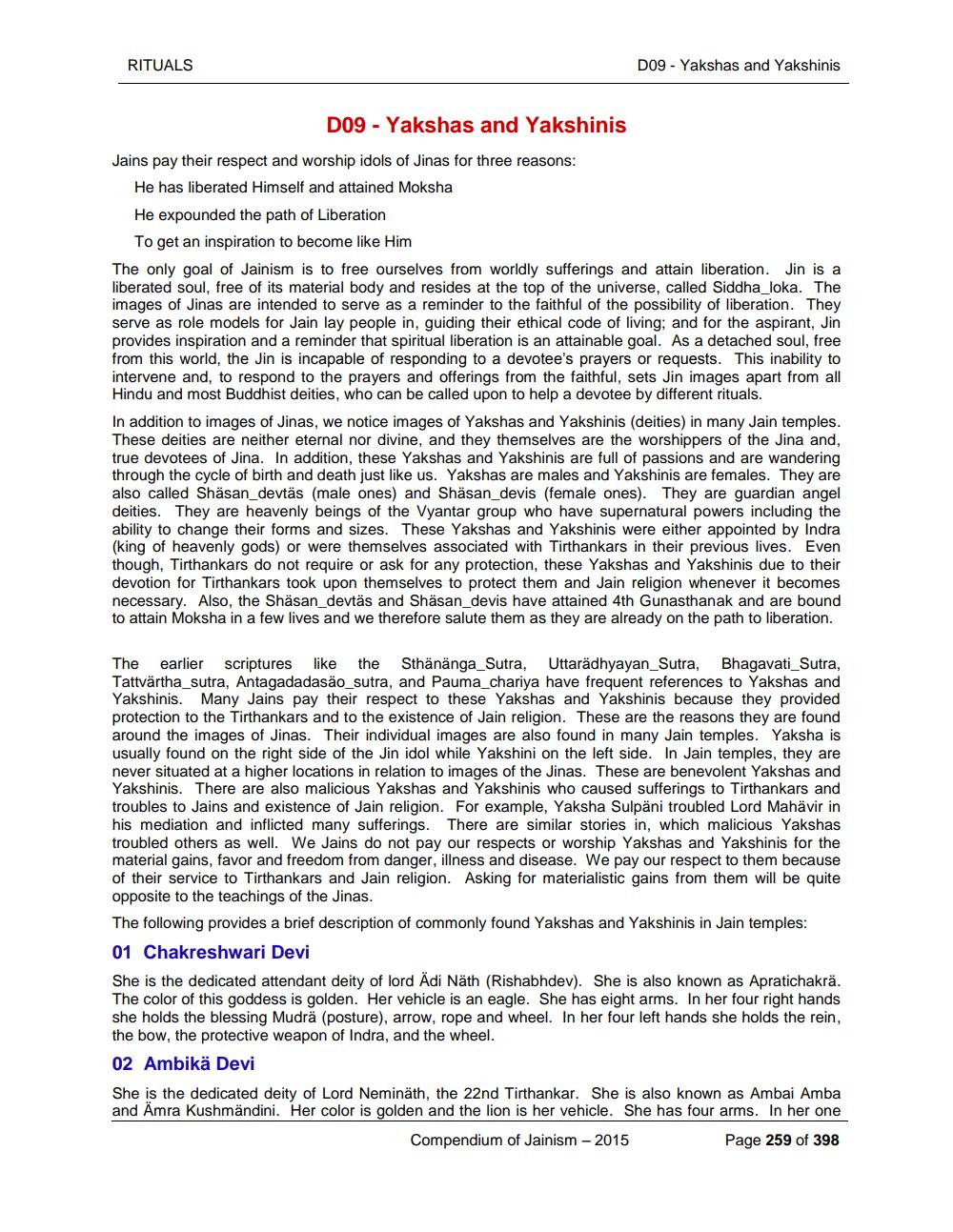________________
RITUALS
D09 Yakshas and Yakshinis
Jains pay their respect and worship idols of Jinas for three reasons:
He has liberated Himself and attained Moksha
He expounded the path of Liberation
To get an inspiration to become like Him
D09 Yakshas and Yakshinis
The only goal of Jainism is to free ourselves from worldly sufferings and attain liberation. Jin is a liberated soul, free of its material body and resides at the top of the universe, called Siddha_loka. The images of Jinas are intended to serve as a reminder to the faithful of the possibility of liberation. They serve as role models for Jain lay people in, guiding their ethical code of living; and for the aspirant, Jin provides inspiration and a reminder that spiritual liberation is an attainable goal. As a detached soul, free from this world, the Jin is incapable of responding to a devotee's prayers or requests. This inability to intervene and, to respond to the prayers and offerings from the faithful, sets Jin images apart from all Hindu and most Buddhist deities, who can be called upon to help a devotee by different rituals.
In addition to images of Jinas, we notice images of Yakshas and Yakshinis (deities) in many Jain temples. These deities are neither eternal nor divine, and they themselves are the worshippers of the Jina and, true devotees of Jina. In addition, these Yakshas and Yakshinis are full of passions and are wandering through the cycle of birth and death just like us. Yakshas are males and Yakshinis are females. They are also called Shäsan_devtäs (male ones) and Shäsan_devis (female ones). They are guardian angel deities. They are heavenly beings of the Vyantar group who have supernatural powers including the ability to change their forms and sizes. These Yakshas and Yakshinis were either appointed by Indra (king of heavenly gods) or were themselves associated with Tirthankars in their previous lives. Even though, Tirthankars do not require or ask for any protection, these Yakshas and Yakshinis due to their devotion for Tirthankars took upon themselves to protect them and Jain religion whenever it becomes necessary. Also, the Shäsan_devtäs and Shäsan_devis have attained 4th Gunasthanak and are bound to attain Moksha in a few lives and we therefore salute them as they are already on the path to liberation.
The earlier scriptures like the Sthänänga Sutra, Uttarädhyayan_Sutra, Bhagavati_Sutra, Tattvärtha_sutra, Antagadadasäo_sutra, and Pauma_chariya have frequent references to Yakshas and Yakshinis. Many Jains pay their respect to these Yakshas and Yakshinis because they provided protection to the Tirthankars and to the existence of Jain religion. These are the reasons they are found around the images of Jinas. Their individual images are also found in many Jain temples. Yaksha is usually found on the right side of the Jin idol while Yakshini on the left side. In Jain temples, they are never situated at a higher locations in relation to images of the Jinas. These are benevolent Yakshas and Yakshinis. There are also malicious Yakshas and Yakshinis who caused sufferings to Tirthankars and troubles to Jains and existence of Jain religion. For example, Yaksha Sulpäni troubled Lord Mahävir in his mediation and inflicted many sufferings. There are similar stories in, which malicious Yakshas troubled others as well. We Jains do not pay our respects or worship Yakshas and Yakshinis for the material gains, favor and freedom from danger, illness and disease. We pay our respect to them because of their service to Tirthankars and Jain religion. Asking for materialistic gains from them will be quite opposite to the teachings of the Jinas.
The following provides a brief description of commonly found Yakshas and Yakshinis in Jain temples: 01 Chakreshwari Devi
She is the dedicated attendant deity of lord Ädi Näth (Rishabhdev). She is also known as Apratichakrä. The color of this goddess is golden. Her vehicle is an eagle. She has eight arms. In her four right hands she holds the blessing Mudrä (posture), arrow, rope and wheel. In her four left hands she holds the rein, the bow, the protective weapon of Indra, and the wheel.
02 Ambikä Devi
She is the dedicated deity of Lord Neminäth, the 22nd Tirthankar. She is also known as Ambai Amba and Ämra Kushmändini. Her color is golden and the lion is her vehicle. She has four arms. In her one
Compendium of Jainism - 2015
Page 259 of 398




